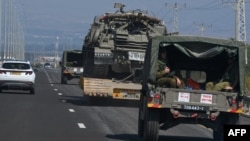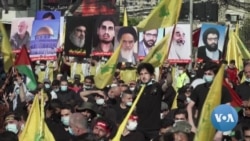The terror attack by the Hamas militant group that killed approximately 1,400 Israeli civilians, and Israel’s determination to destroy the Palestinian militant group in return, may be the start of a new, painful chapter in a region already badly scarred by decades of conflict and violence.
Current and former officials, analysts and aid groups, speaking to VOA directly and at public forums, warn that unlike past conflicts between Israel and Hamas, when each side sought to damage the other before eventually easing off, this time is different.
Despite some considerable differences of opinion, almost all agree that the nature of the Hamas attack has broken the tit-for-tat cycle of violence that has characterized hostilities for most of the past two decades. And they warn that the Israeli effort to eradicate the threat from Hamas could leave Gaza, Israel and the larger Middle East much messier, if not less stable, than ever before.
“Hamas has departed from the script that Israel assigned it for years,” according to Jon Alterman, director of the Middle East program at the Center for Strategic and International Studies.
The initial terror attack “was surely only the first act that Hamas had planned,” he said. “They knew it was going to be followed by airstrikes and a ground invasion. … What other surprises do they have planned?”
Former officials and analysts say that is, perhaps, the key question facing Israel’s military as it prepares for an expected ground assault against Hamas and its allies in Gaza.
And some, like Middle East Institute senior fellow Nimrod Goren, note that although Israel has a more powerful military and superior technology, past incursions showed that fighting in the streets of Gaza “usually doesn’t end very well” for the Israeli military.
Israel’s last military incursion in 2014 resulted in the deaths of 67 soldiers when Israeli troops met stiff resistance while never penetrating more than a few kilometers into Gaza.
This time, Israeli military commanders have promised a much more thorough campaign.
“The goal of Israel, as has been announced, is to try and get Hamas out of Gaza in terms of military capabilities and governing capability,” Goren said.
“It's not only about taking control and deterring like last time, but it's now about changing who is ruling Gaza,” he said. “It's about reshaping the order in Gaza.”
And most officials and analysts expect Israel will face a much stiffer test than it did nine years ago.
Hamas capabilities
U.S. intelligence estimates put the number of Hamas fighters at between 20,000 and 25,000, though some estimates say the number might be 30,000 or higher, bolstered by support from about a dozen other militant groups in Gaza.
Hamas’ firepower, due to its own initiative and support from Iran, is also formidable.
Already, Hamas has fired thousands of rockets into Israel, and experts believe it has plenty more at its disposal.
“Their arsenal has grown exponentially over the years, and a lot of that is self-manufactured,” said Joe Truzman, a research analyst at the Washington-based Foundation for Defense of Democracies.
“They have rockets that will target areas near the Gaza border, and that's complemented with mortar fire. They have medium-range rockets that, let's say, can actually reach a little bit further,” Truzman told VOA.
“And then you have the long-range rockets,” he said. “They're able to attack major cities like Tel Aviv and Jerusalem.”
U.S. officials also assess Hamas has plenty of weaponry that would allow it to cause problems for Israeli forces poised to enter Gaza — including small arms, rocket-propelled grenades, man-portable air defense systems (MANPADS) and anti-tank missiles.
Hamas also displayed its ability to use drones during its initial attack on Israel, using the aerial devices to attack Israeli military observation towers. It also is thought to have drones that can attack Israeli naval assets; Israel has accused Hamas of using unmanned underwater drones for an attempted attack in 2018.
Additionally, Hamas has shown an ability to learn and apply those lessons.
“They're operating like an army,” said Truzman, adding that for most of the past five years, Hamas has operated its own joint operations room. “It’s about 10 to 12 armed groups, terrorist groups, in the Gaza Strip, all affiliated with Hamas that coordinate with one another during times of conflict.”
Gaza’s tunnels
Hamas also has shown a capacity to use an extensive system of tunnels underneath Gaza to its advantage.
During previous fighting with Israel, Hamas used the tunnels to deploy rocket units to launch attacks and quickly disappear to evade retaliatory strikes. And in 2014, Hamas used the tunnels to ambush Israeli forces that entered Gaza.
Analysts expect the tunnels will at least slow down any ground operation by Israel, if not give Hamas an opportunity to inflict heavy casualties.
“If you really want to root out Hamas and break Hamas as a military organization, you have to go all the way in,” said Raphael Cohen, a senior political scientist at the RAND Corporation. “You have to fight underground.”
“Hamas knows this and has been working presumably on booby traps and [the] like,” Cohen said. “That looks very, very messy.”
Fighting Hamas above ground is also expected to be difficult for Israeli forces.
“The way that Hamas is dispersed in everybody's basement and everybody's apartment building and in every part of the city, that's going to be really challenging,” warned Thomas Trask, a retired U.S. lieutenant general who previously served as vice commander at U.S. Special Operations Command.
“It's just going to be a block-by-block, very difficult slog,” he said.
Israel is likely to counter with armored vehicles, tanks and bulldozers.
But Gaza’s cramped quarters may make advancing difficult.
The narrow stretch of land bordering Israel and the Mediterranean coast is some 40 kilometers long and about 13 kilometers wide at its widest point and is home to more than 2 million Palestinians. Some observers and analysts have described Gaza as perhaps the most densely populated piece of land in the world.
Additionally, if Israel makes good on its pledge to eliminate Hamas, its forces will have to penetrate deeper into Gaza than they have since Israel left Gaza in 2005.
Close quarters
“You’ve got narrow alleys. You’ve got concrete buildings of different heights. You’ve got warrens,” said Seth Jones, director of the international security program at CSIS.
“Hamas, and actually other groups … they have an intimate knowledge of Gaza’s streets and alleys, underground facilities, including tunnels, buildings,” Jones said. “So, as IDF [Israel Defense Force] soldiers make their way through Gaza, they’ve got to have to deal with the improvised explosive devices, suicide bombers, anti-tank missiles, RPGs, drones.”
And stuck in between Hamas and the Israeli forces are civilians, not all of whom are willing or able to respond to Israeli demands to use designated evacuation routes to escape the fighting.
“People have nowhere to shelter,” said Tahani Mustafa, the Palestine senior analyst for the International Crisis Group.
“They don't have safe rooms. They don't have bomb shelters,” Mustafa told VOA from London, adding that she had left Gaza shortly before the fighting began.
“So, Hamas can try and tell people to stay as safe as possible,” she said. “But ultimately, how people are doing that is basically congregating in homes of different relatives, friends, in certain facilities like UNRWA [United Nations Relief and Works Agency] schools, hospitals."
As of Tuesday, an estimated 600,000 are thought to have heeded Israeli requests to leave northern Gaza, expected to be the initial front in the offensive. But Jones said the mere presence of civilians, some of whom may decide to take up arms, will make the likely Israeli offensive more daunting.
“IDF soldiers have ... extraordinary competence in operations in both the West Bank and Gaza, and obviously up north in Lebanon,” he said during a call, in response to a question from VOA.
“But when you’re facing extraordinary stress — Hamas and other militants and civilians trying to kill you in a densely packed urban environment and have to make very quick decisions with your finger on the trigger with imperfect information — it’s going to lead to civilian casualties,” Jones said.
Already, Israel’s aerial campaign against Hamas in Gaza has inflicted a toll.
According to the Gaza Health Ministry, as of Tuesday, Israeli airstrikes have killed about 3,000 people, about a quarter of them children, and wounded 12,500 more. Most are thought to be civilians, though it is unclear how many of them are Hamas fighters or members of other militant groups.
Further complicating the likely offensive, Israeli and U.S. officials have accused Hamas of purposely putting Palestinian civilians in harm’s way.
Human shields
“They're using innocent men, women and children as human shields, operating in tunnels underneath their homes, headquartering themselves in hospitals and schools,” U.S. National Security Council spokesman John Kirby told reporters Friday.
“They're [Hamas] even putting up roadblocks to block any safe passage for civilians who are trying to depart out of these urban neighborhoods, which have become combat zones,” Kirby added.
IDF officials have echoed those accusations, sharing photos on social media claiming to show Hamas blockading the escape routes.
But Palestinian officials and some aid groups in Gaza have rejected the accusations, alleging Israel’s military has been indiscriminate in its bombing campaign, sometimes targeting hospitals and schools on purpose.
“At least six people were killed this afternoon when an UNRWA school was hit in al-Maghazi refugee camp, in Gaza’s middle area,” UNRWA Commissioner-General Philippe Lazzarini said in a statement Tuesday.
“This is outrageous, and it again shows a flagrant disregard for the lives of civilians,” he said. “No place is safe in Gaza anymore, not even UNRWA facilities.”
“A lot of these buildings are very clearly marked,” the Internation Crisis Group’s Mustafa told VOA prior to Tuesday’s bombing, calling the U.S. and Israeli accusations “absolutely preposterous.”
“To claim that Hamas is using human shields, that's implying that UNWRA was complicit in allowing Hamas to use its facilities,” she said.
Other analysts warn, accusations aside, that many Palestinians in Gaza are reluctant to leave because they fear they will never be allowed back.
“For a lot of Palestinians, this is a prelude to another Nakba,” said Khaled Elgindy, director of Palestine and Israeli-Palestinian affairs at the Middle East Institute, referring to 1948, when hundreds of thousands of Palestinians fled their homes following the war that led to Israel’s creation.
“I think that's not entirely off the table,” he said. “I think Egypt has similar fears.”
Expansion
One of the most prominent fears has been the possibility that the fighting between Israel and Hamas will not be limited to Gaza but could engulf much of the Middle East.
The United States, especially, has been wary that Iran and its proxies, including Lebanese Hezbollah, might try to take advantage of the situation and join the fight against Israel.
“For any country, for any group or anyone thinking about trying to take advantage of this atrocity, to try to widen the conflict or to spill more blood, we have just one word: Don't,” U.S. Defense Secretary Lloyd Austin said Friday during a visit to Israel, echoing similar comments by U.S. President Joe Biden.
The U.S. military has backed up the talk with deployments, sending two carrier strike groups to the Eastern Mediterranean.
The Pentagon has also sent additional fighter jets to the region.
The moves signal Washington’s “resolve to deter any state or non-state actor seeking to escalate the war,” Austin said in a statement Sunday.
But Iran, a longtime supporter of Hamas, has refused to back down.
“With God’s grace, this movement that has started in #Palestine will advance and result in a complete victory for the Palestinians,” Iran’s supreme leader wrote Sunday in a post on the social media platform X, formerly known as Twitter.
Just a day earlier, Iranian Foreign Minister Hossein Amirabdollahian hinted to reporters in Beirut that Tehran or its proxies could join the war.
“If these organized war crimes that are committed by the Zionist entity don't stop immediately, then we can imagine any possibility,” he said.
And some Iranian-linked groups seem to be preparing.
Phillip Smyth, a former fellow at The Washington Institute for Near East Policy who studies Iran's proxy groups, said Iranian-linked militias in Iraq are starting to mobilize like they did in early- to mid-2014 before deploying fighters to Syria.
“The narrative structuring is similar in terms of developing the accepted line for why they must fight and how Iran is being both patient and supporting the wider resistance,” he told VOA by text.
In Lebanon, Hezbollah has also signaled it will be ready to fight.
“We don't want to reveal what the next step is,” said Hezbollah legislator Hassan Fadlallah, adding that whatever it is, it “is tied to what is going on in Gaza."
Hezbollah
The latest U.S. intelligence estimates say that as of September 2022, Hezbollah had approximately 40,000 fighters with “state-like military capabilities,” to include air defense systems, Russian-developed anti-ship and anti-tank missiles, precision-guided missiles and drones.
And according to the Missile Defense Project at CSIS, Hezbollah has an estimated 130,000 rockets at its disposal.
Already, there has been sporadic fighting and rocket attacks by Hezbollah along the Israel-Lebanon border.
U.S. officials have said so far, they have not seen signs the Iranian-backed group is preparing to enter the war. But some analysts caution that may not be Hezbollah’s plan.
“My assessment is they’d like their contribution to be limited to distracting Israel and drawing resources to the north,” said CSIS’s Alterman. “But I can certainly see circumstances where Hezbollah is drawn into full-scale conflict. And that would have devastating impacts on both Israel and Lebanon.”
As for Iran, despite its long-standing support of Hamas, there are those who think Tehran will be content to fan the flames of war from afar.
“The way Iran works is it goes into a geography. It identifies a promising arsonist. It then empowers, trains and resources that arsonist to dominate all the other arsonists in its area, in that geography. And then it gives that arsonist very specific matches,” said Norman Roule, a former U.S. intelligence manager for Iran who is now a senior adviser at CSIS.
Foreign fighters
U.S. counterterrorism and military officials are also wary of another threat: the possibility that foreign fighters will try to join with Hamas.
Military officials say they are already tracking reports that some would-be jihadists, including some who have fought with terror groups like al-Qaida and Islamic State, are interested in making their way to Israel.
One former Western counterterrorism official told VOA the Hamas attack could certainly galvanize anyone who sees Israel as an enemy.
However, some analysts question whether this sort of help for Hamas is possible.
“There's a variety of actors that have made these pledges,” the RAND Corporation’s Cohen said in response to a question from VOA.
“The catch here is that Gaza currently is under full-on blockade,” he added. “And because it’s a full-on blockade, even if there is [the] will, the question is how do you get stuff into Gaza?”
Endgame
For the moment, the Israel-Hamas war appears to be in a deadly holding pattern, with Israeli warplanes targeting suspected Hamas fighters and facilities across Gaza, while Hamas and other militant groups continue to bombard Israel with rocket and missile attacks.
And the Israeli government, for the moment, may be further emboldened by U.S. support.
"Israel has to respond. They have to go after Hamas,” Biden told CBS News’ “60 Minutes” in a segment that aired Sunday.
And so, it is likely only a matter of time before Israel’s military rolls into Gaza, with battles raging on the ground and in the tunnels below.
“The objectives are very clear. The objectives are to destroy Hamas, completely eradicate it from the Gaza Strip, and make sure that they'll never be able to build themselves again,” said Amir Avivi, a retired Israeli brigadier general and founder of the Israel Defense and Security Forum, a group of thousands of Israeli reserve officers and operatives.
Achieving that, however, will not be quick or easy, he said.
“To do that, we need to regain control of Gaza. We need to conquer Gaza,” Avivi said. “At least a few months it will take us to really clean up the whole Gaza Strip from any terrorist presence.”
“Gaza will be completely different after this war ends,” he added.
Other analysts are convinced that such an outcome is simply not realistic.
“Even if it were possible, what would fill the vacuum? Who's going to rule? Who's going to govern Gaza?” asked Elgindy of the Middle East Institute, also questioning whether Hamas has adequately thought through the aftermath of its initial terror attack.
“What is Hamas' endgame? I think that's been the million-dollar question that everyone has been asking,” he said. “And I don't think there's a ready answer, because Hamas, I think … they ended up being far more successful than they imagined or hoped or planned for.”
The International Crisis Group’s Mustafa sees it differently.
“Ultimately, this operation was a huge gamble on Hamas' part. But the other option for them was to continue with an indefinite siege on Gaza,” she told VOA. “The status quo is so unsustainable.”
“This is make or break it for Hamas. So, they are in this for the long run, and they've made that clear,” she added.
“Ultimately, no one's going to win here, especially Israel,” she said. “One way or another, Israel will come out of it a completely fragmented society.”
Margaret Besheer at the United Nations contributed to this report. Some information from Reuters and The Associated Press was also used.















